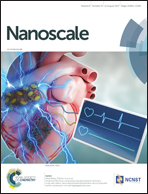Switchable changes in the conductance of single-walled carbon nanotube networks on exposure to water vapour†
Abstract
We have discovered that wrapping single-walled carbon nanotubes (SWCNTs) with ionic surfactants induces a switch in the conductance-humidity behaviour of SWCNT networks. Residual cationic vs. anionic surfactant induces a respective increase or decrease in the measured conductance across the SWCNT networks when exposed to water vapour. The magnitude of this effect was found to be dependent on the thickness of the deposited SWCNT films. Previously, chemical sensors, field effect transistors (FETs) and transparent conductive films (TCFs) have been fabricated from aqueous dispersions of surfactant functionalised SWCNTs. The results reported here confirm that the electrical properties of such components, based on randomly orientated SWCNT networks, can be significantly altered by the presence of surfactant in the SWCNT layer. A mechanism for the observed behaviour is proposed based on electrical measurements, Raman and UV-Vis-NIR spectroscopy. Additionally, the potential for manipulating the sensitivity of the surfactant functionalised SWCNTs to water vapour for atmospheric humidity sensing was evaluated. The study also presents a simple method to establish the effectiveness of surfactant removal techniques, and highlights the importance of characterising the electrical properties of SWCNT-based devices in both dry and humid operating environments for practical applications.



 Please wait while we load your content...
Please wait while we load your content...